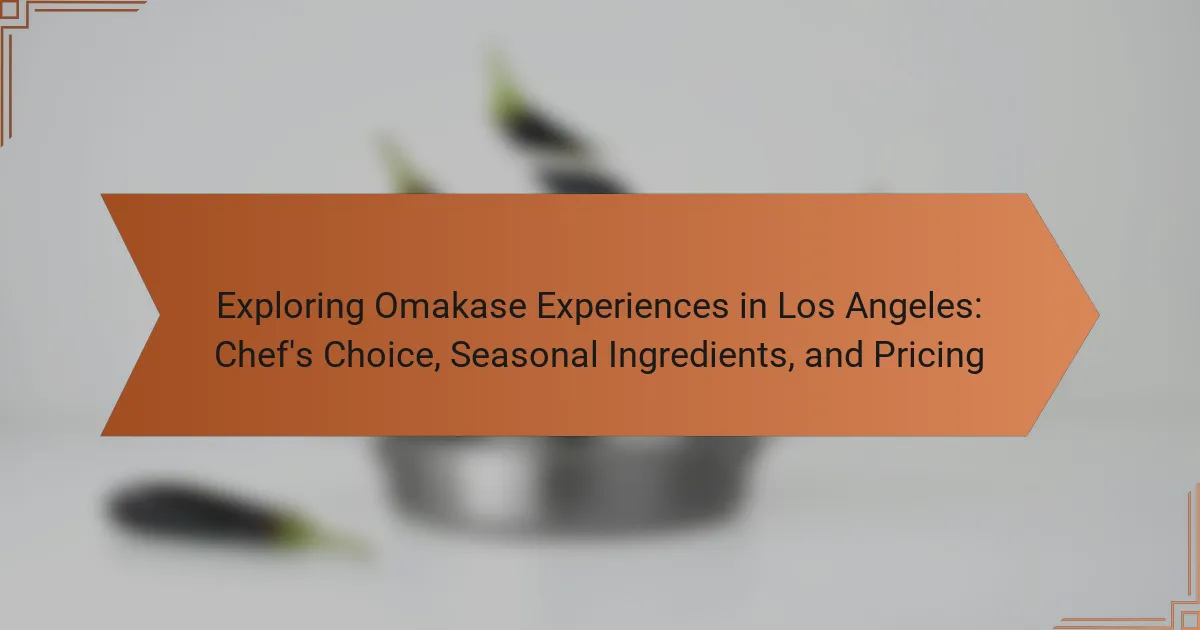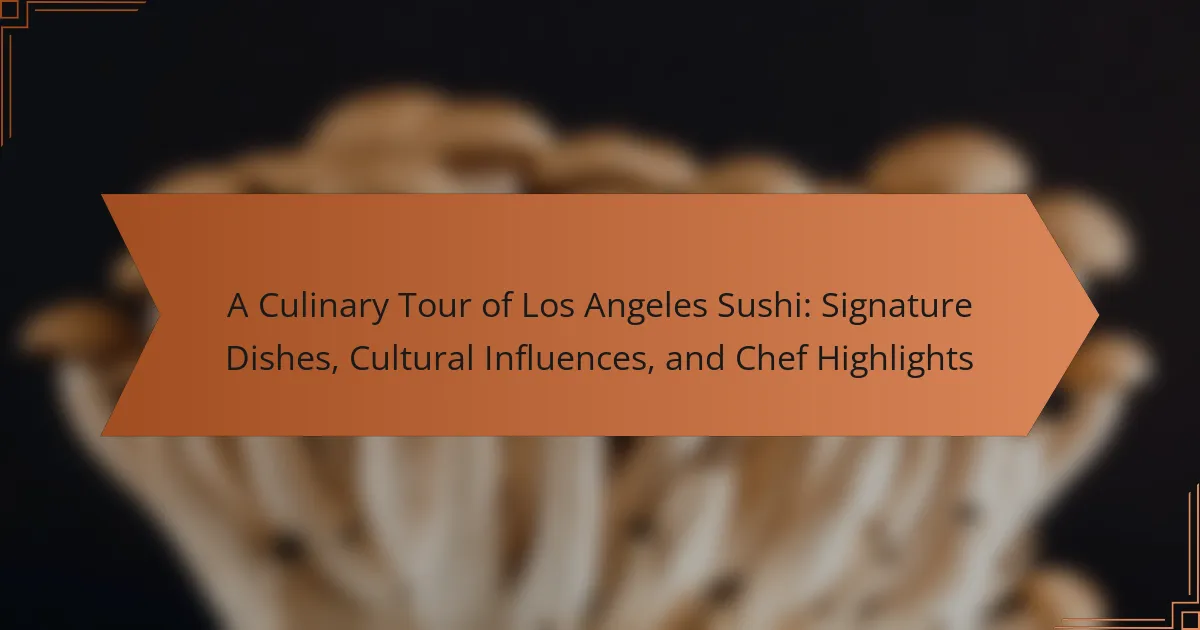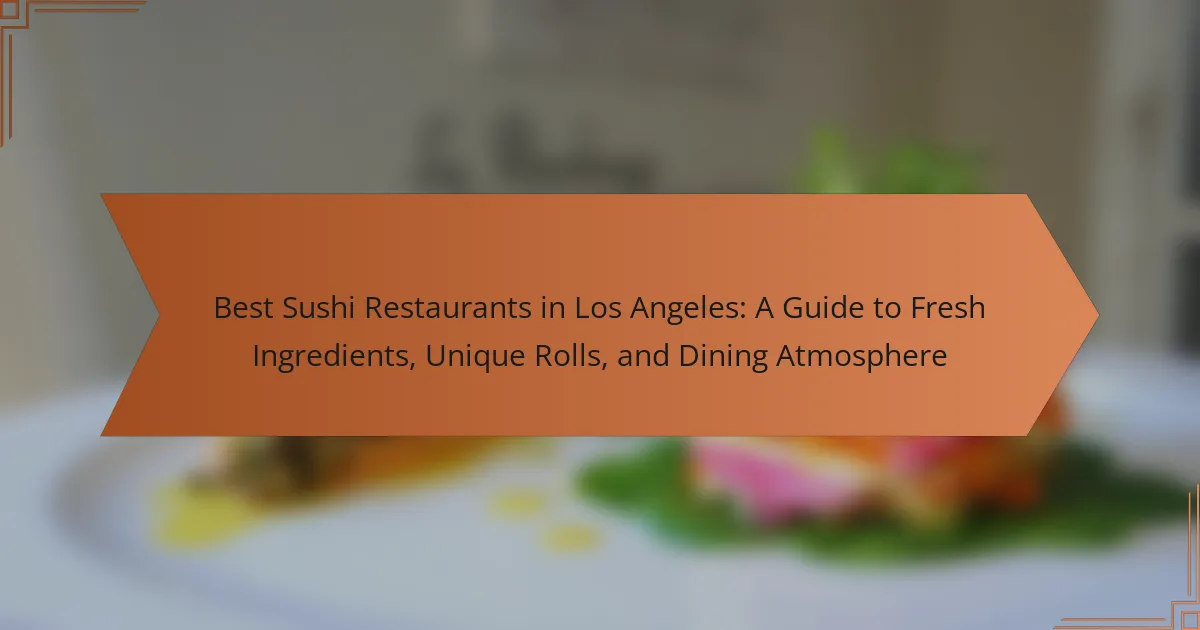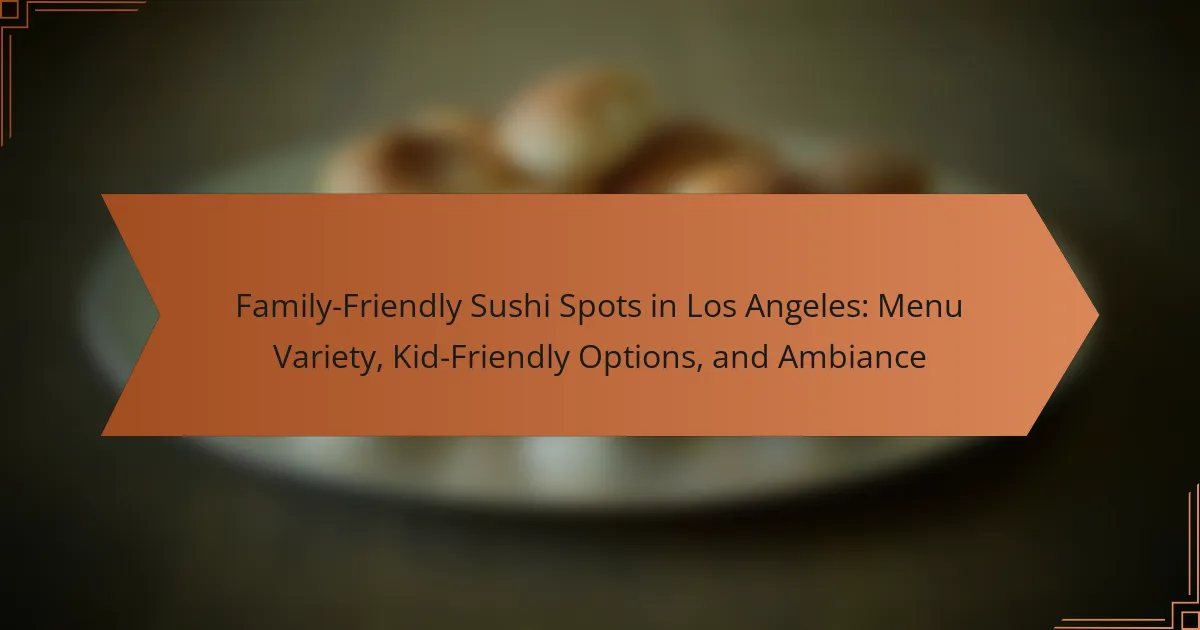Sushi etiquette in Los Angeles encompasses key customs related to dining practices, chopstick usage, chef appreciation, and tipping standards. Proper chopstick etiquette involves avoiding the placement of chopsticks upright in rice and instead using a holder. Expressing gratitude to the sushi chef enhances the dining experience, while tipping typically ranges from 15-20% of the total bill. Regional variations exist, with Little Tokyo emphasizing traditional practices, Westside locations offering fusion styles, and the San Fernando Valley providing a mix of casual and upscale options. To improve the sushi dining experience, it is advisable to choose reputable restaurants, understand the menu, and follow traditional etiquette regarding soy sauce and wasabi usage.

What are the key aspects of Sushi Etiquette in Los Angeles?
Key aspects of sushi etiquette in Los Angeles include proper chopstick usage, appreciation of the chef, and appropriate tipping. Diners should avoid sticking chopsticks upright in rice, as this resembles a funeral ritual. Instead, resting chopsticks on a holder is recommended. Expressing gratitude to the sushi chef enhances the dining experience. Tipping is typically 15-20% of the total bill. Many sushi restaurants in Los Angeles follow this standard, reflecting the quality of service received. Understanding these customs ensures a respectful and enjoyable dining experience.
How do dining customs in Los Angeles influence sushi etiquette?
Dining customs in Los Angeles significantly influence sushi etiquette. The diverse population in Los Angeles incorporates various cultural practices into dining experiences. This blending of customs affects how sushi is consumed and appreciated. For example, communal dining is common, encouraging sharing dishes among diners. This practice contrasts with traditional sushi etiquette, which often emphasizes individual servings. Additionally, Los Angeles diners frequently engage in casual dining settings. This informality can lead to relaxed approaches to sushi etiquette, such as using hands instead of chopsticks. Tipping practices in Los Angeles also differ from traditional sushi restaurants. Diners often tip generously, reflecting the service-oriented culture of the city. These customs shape a unique sushi dining experience that balances tradition with local influences.
What are the traditional dining customs associated with sushi in Los Angeles?
Traditional dining customs associated with sushi in Los Angeles include specific practices that enhance the dining experience. Diners often greet sushi chefs with a polite “Irasshaimase,” acknowledging their presence. It is customary to eat sushi with chopsticks, although some prefer to use their hands for nigiri.
Sushi is typically enjoyed in a specific order, starting with lighter flavors and progressing to richer ones. Many diners appreciate the art of omakase, where the chef selects dishes based on seasonal ingredients.
Tipping practices vary, but it is common to leave a gratuity of 15-20% for good service. Additionally, diners often express gratitude to the chef after their meal, reinforcing respect for the culinary craft. These customs reflect a blend of Japanese tradition and local adaptation in Los Angeles.
How do cultural influences shape sushi dining experiences in the city?
Cultural influences significantly shape sushi dining experiences in the city. These influences dictate the customs and practices observed during meals. For instance, Japanese traditions emphasize respect and mindfulness in dining. This is reflected in the etiquette surrounding sushi consumption, such as not mixing wasabi into soy sauce. Additionally, local adaptations may incorporate diverse flavors and ingredients, catering to the city’s multicultural demographic. The presence of various Asian communities in Los Angeles also introduces unique serving styles and interpretations of sushi. This blend of traditional and modern practices creates a dynamic dining atmosphere. Cultural festivals and events further enhance the sushi experience by celebrating these diverse influences.
What serving styles are common in sushi restaurants in Los Angeles?
Common serving styles in sushi restaurants in Los Angeles include omakase, nigiri, and maki. Omakase is a chef’s choice meal where diners trust the chef to select dishes. Nigiri consists of hand-formed rice topped with fish or seafood. Maki refers to rolled sushi wrapped in seaweed. Many restaurants also offer sashimi, which is sliced raw fish served without rice. Each style showcases different aspects of sushi craftsmanship. These serving styles are prevalent due to the diverse culinary influences in Los Angeles.
How does omakase differ from other serving styles?
Omakase differs from other serving styles by offering a chef-curated dining experience. In omakase, diners trust the chef to select dishes based on seasonal ingredients and personal expertise. This contrasts with a la carte dining, where customers choose individual items from a menu. Omakase typically involves multiple courses, showcasing a variety of flavors and techniques. The experience emphasizes freshness and artistry in presentation. Additionally, omakase often requires a reservation, highlighting its exclusivity. This style is rooted in traditional Japanese dining customs, enhancing its cultural significance.
What role does presentation play in sushi serving styles?
Presentation plays a critical role in sushi serving styles. It enhances the visual appeal of the dish, making it more enticing to diners. A well-presented sushi plate showcases the chef’s skill and attention to detail. This aesthetic quality often influences the overall dining experience. For instance, traditional Japanese presentation emphasizes balance and harmony. The arrangement of sushi pieces can reflect seasonal themes or cultural significance. Additionally, the use of garnishes and serving ware further elevates the dish’s presentation. This focus on visual elements aligns with the cultural importance of aesthetics in Japanese cuisine. Ultimately, presentation in sushi serving styles is integral to both enjoyment and appreciation of the culinary art.
Why is tipping an important aspect of sushi dining in Los Angeles?
Tipping is an important aspect of sushi dining in Los Angeles because it directly impacts the service staff’s income. Sushi chefs often work long hours and rely on tips to supplement their earnings. In Los Angeles, tipping is generally expected and reflects the diner’s appreciation for the quality of food and service. A customary tip ranges from 15% to 20% of the total bill. This practice encourages attentive service and fosters a positive dining experience. Additionally, tipping can influence the quality of sushi preparation and presentation. Many sushi restaurants in Los Angeles emphasize the artistry involved in making sushi, which is often enhanced by a chef’s motivation driven by tips.
What are the standard tipping practices in sushi restaurants?
Standard tipping practices in sushi restaurants typically range from 15% to 20% of the total bill. Customers often tip based on the level of service received. In more upscale sushi establishments, a tip closer to 20% is common if the service is exceptional. Some diners may choose to tip more for omakase experiences, where chefs provide a curated meal. It is also customary to tip the sushi chef directly in some cases. This direct tipping acknowledges the chef’s skill and effort. In Los Angeles, tipping practices may vary slightly based on the restaurant’s ambiance and clientele. Overall, showing appreciation through tipping is an important aspect of dining etiquette in sushi restaurants.
How does the level of service affect tipping amounts?
The level of service directly influences tipping amounts. Higher quality service typically results in larger tips. For example, attentive servers who provide prompt and friendly service often receive tips exceeding 20% of the bill. In contrast, poor service may lead to tips below 15% or none at all. Research indicates that customers gauge their tipping based on their overall dining experience. Specific factors include server responsiveness, knowledge of the menu, and the ability to accommodate special requests. A study by Lynn and Grassman (1990) found that perceived service quality significantly affects tipping behavior. Thus, customers tend to reward exceptional service with higher gratuities.
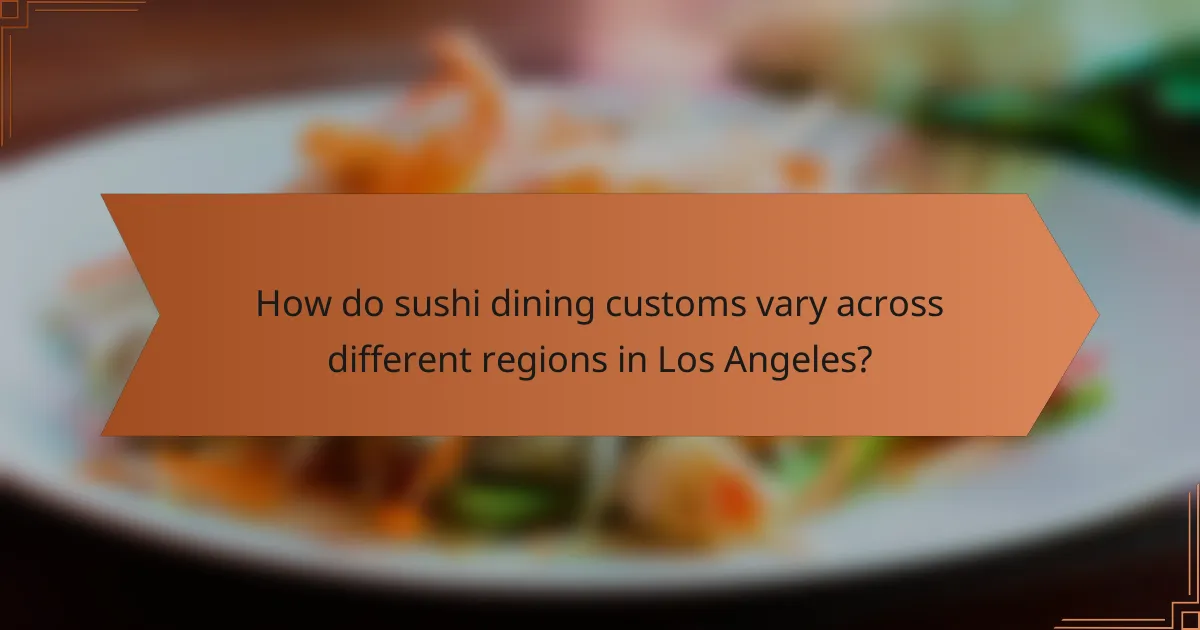
How do sushi dining customs vary across different regions in Los Angeles?
Sushi dining customs in Los Angeles vary significantly by region. In Little Tokyo, traditional practices are emphasized. Diners often enjoy sushi at the counter, interacting with the chef. In contrast, Westside locations focus on a fusion approach. They incorporate diverse ingredients and flavors, appealing to a broader audience. The San Fernando Valley showcases a mix of casual and upscale sushi experiences. Many diners prefer all-you-can-eat options in this area. Tipping practices also differ; higher tips are common in upscale venues. Authentic spots may see lower tips, reflecting traditional Japanese customs. These regional differences highlight the diverse sushi culture in Los Angeles.
What are the unique sushi dining experiences in various neighborhoods?
Unique sushi dining experiences in various neighborhoods of Los Angeles include a range of styles and atmospheres. In Little Tokyo, diners can enjoy traditional Edomae sushi, emphasizing fresh fish and simplicity. The Arts District offers trendy sushi bars with creative rolls and vibrant decor. West LA features upscale omakase experiences, where chefs prepare personalized tastings. In Koreatown, fusion sushi combines Korean flavors with classic Japanese techniques. Each neighborhood presents a distinct cultural influence, enhancing the overall dining experience. These variations reflect the diverse culinary landscape of Los Angeles.
How do local demographics influence sushi etiquette and customs?
Local demographics significantly influence sushi etiquette and customs. In Los Angeles, a diverse population shapes various dining practices. For instance, the presence of a large Asian community leads to traditional sushi customs being more widely respected. These customs include proper chopstick usage and the significance of omakase dining.
Conversely, demographics with less familiarity may adopt more casual eating habits. This can result in variations like using hands to eat sushi or altering traditional serving styles. Additionally, tipping practices vary among cultures. Some communities may tip generously, while others may adhere to standard percentages.
This diversity creates a unique sushi dining experience in Los Angeles. It reflects a blend of traditional Japanese etiquette and local adaptations, influenced by the city’s multicultural landscape.
What are some notable sushi hotspots and their specific dining styles?
Sushi hotspots in Los Angeles include Sushi Gen, Katsuya, and Sugarfish. Sushi Gen offers traditional Edomae-style sushi, emphasizing fresh fish and simple presentation. Katsuya is known for its modern twist on sushi, featuring creative rolls and a vibrant atmosphere. Sugarfish focuses on a no-frills omakase experience, highlighting quality fish and authentic flavors. Each hotspot reflects unique dining styles, catering to diverse preferences in sushi consumption.
What are the common misconceptions about sushi etiquette in Los Angeles?
Common misconceptions about sushi etiquette in Los Angeles include the belief that soy sauce should be poured over sushi. This practice can overwhelm the delicate flavors. Many also think that wasabi should always be mixed into soy sauce. Authentic sushi is typically served with wasabi already included. Another misconception is that it is acceptable to eat sushi rolls with a fork. Sushi is traditionally eaten with hands or chopsticks. Some diners believe that it is rude to finish all the rice on the plate. In fact, finishing the rice is often seen as a compliment to the chef. Lastly, many assume that tipping is unnecessary at sushi bars. In Los Angeles, tipping is customary and appreciated for good service.
How do these misconceptions affect the dining experience?
Misconceptions about sushi etiquette significantly impact the dining experience. When diners believe that sushi should only be eaten with chopsticks, they may miss the authentic experience of using hands. This can lead to discomfort and hesitation in enjoying the meal fully. Misunderstandings regarding the appropriate way to consume wasabi can also detract from flavor enjoyment. If diners mix wasabi into soy sauce, they may not appreciate the intended balance of flavors. Additionally, misconceptions about tipping can create awkwardness. Knowing that tipping is not mandatory in sushi dining may relieve stress for some diners. These factors can lead to a less enjoyable meal and hinder the appreciation of sushi culture. Understanding proper etiquette enhances the overall dining experience by fostering respect and enjoyment.
What can diners do to avoid etiquette faux pas?
Diners can avoid etiquette faux pas by familiarizing themselves with sushi dining customs. Understanding the proper way to eat sushi is essential. For example, using chopsticks correctly is important. Diners should avoid rubbing chopsticks together, as it implies they are cheap. Additionally, it is advisable to eat sushi in one bite to appreciate the flavors.
Diners should also be mindful of dipping sushi. Only the fish side should be dipped in soy sauce, not the rice. This practice helps maintain the integrity of the sushi. Furthermore, when dining in a sushi bar, it is polite to engage with the sushi chef. A simple greeting shows respect and appreciation.
Finally, tipping appropriately is crucial in Los Angeles sushi restaurants. A standard tip is around 15-20% of the total bill. These practices help diners enjoy their meal while respecting sushi traditions.
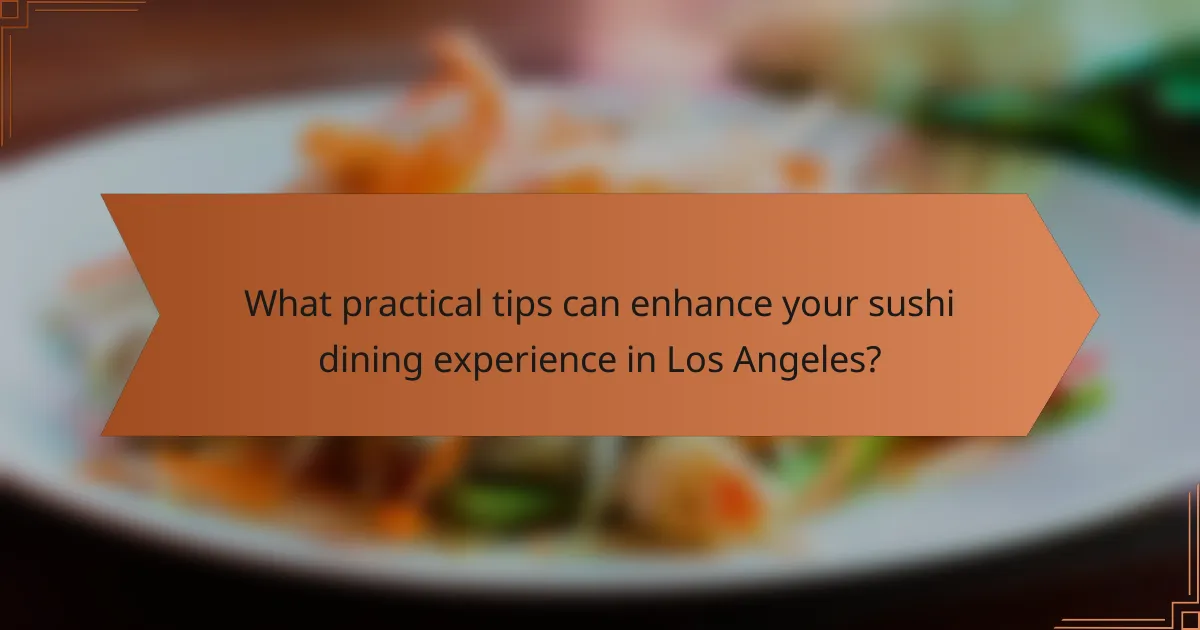
What practical tips can enhance your sushi dining experience in Los Angeles?
To enhance your sushi dining experience in Los Angeles, consider these practical tips. First, choose a reputable sushi restaurant known for quality ingredients. Fresh fish is critical for optimal flavor and safety. Second, arrive early or make reservations to avoid long wait times. Popular spots can fill up quickly, especially on weekends. Third, understand the menu. Familiarize yourself with sushi terms like nigiri, sashimi, and rolls. This knowledge helps in making informed choices. Fourth, try the chef’s omakase option. This allows the chef to select the best dishes for you. Fifth, use soy sauce sparingly. Dipping the fish side, not the rice, preserves flavor and texture. Sixth, avoid mixing wasabi into soy sauce. Traditional etiquette suggests placing wasabi directly on the fish. Lastly, show appreciation with a polite thank you to the chef. This enhances the dining experience and respects the craft.
How can you prepare for your first sushi dining experience?
Research sushi types and menu options before dining. Familiarize yourself with common sushi terms like nigiri and sashimi. Consider dietary preferences or restrictions. Arrive with an open mind to try new flavors. Learn about proper chopstick use and etiquette. Understand that sushi is often served in courses. Be prepared to share dishes if dining with others. Know that tipping is customary in Los Angeles, typically 15-20%.
What should you know about ordering and tasting sushi?
When ordering and tasting sushi, it’s essential to understand the different types available. Sushi can include nigiri, sashimi, and rolls, each with unique preparation methods. Choose a reputable sushi restaurant known for freshness and quality. It’s crucial to ask the chef for recommendations, especially for seasonal fish. When tasting sushi, use chopsticks or your hands, but avoid mixing wasabi into soy sauce. Take small bites to savor the flavors fully. Eating sushi in one bite is customary, as it enhances the experience. Freshness is key; sushi should be consumed soon after it’s prepared.
How can you respectfully engage with sushi chefs and staff?
To respectfully engage with sushi chefs and staff, approach them with politeness. Use a friendly tone when greeting them. Make eye contact to show attentiveness. Avoid interrupting their work unless necessary. When placing an order, be clear and concise. Express gratitude for their service after receiving your meal. Compliment their skills if you enjoy the food. Understanding and following these practices enhances the dining experience. Respect is a core value in Japanese culture, especially in sushi dining.
What are some best practices for enjoying sushi in Los Angeles?
To enjoy sushi in Los Angeles, prioritize freshness and quality. Choose reputable sushi restaurants known for sourcing high-quality fish. Look for establishments that offer seasonal and local ingredients. When dining, consider ordering omakase for a curated experience. This allows the chef to select the best offerings of the day. Use chopsticks or your hands for nigiri; both are acceptable. When consuming sushi, eat it in one bite for optimal flavor. Pair sushi with soy sauce, but avoid soaking it. This preserves the delicate flavors of the fish. Lastly, tipping is customary; 15-20% is standard for good service.
How can you make the most of your sushi outing?
To make the most of your sushi outing, select a reputable sushi restaurant known for quality. Research reviews and ratings online to find the best options in Los Angeles. Arrive early to avoid long wait times, especially during peak hours. Familiarize yourself with sushi types and menu items to enhance your ordering experience. Consider trying a chef’s omakase for a curated experience that showcases the chef’s skills. Pair your sushi with appropriate beverages, like sake or green tea, to complement the flavors. Lastly, practice proper dining etiquette, such as using chopsticks correctly and refraining from mixing wasabi into soy sauce, to show respect for the cuisine.
What etiquette guidelines should you follow when dining with others?
When dining with others, follow these etiquette guidelines to ensure a pleasant experience. First, arrive on time to show respect for your companions. Second, wait for everyone to be served before starting to eat. Third, use utensils properly according to the type of cuisine, such as chopsticks for sushi. Fourth, engage in polite conversation and avoid discussing controversial topics. Fifth, be mindful of noise levels while eating and speaking. Sixth, express gratitude to the host or server when appropriate. These guidelines promote a respectful and enjoyable dining atmosphere.
The main entity of this article is sushi etiquette in Los Angeles, encompassing dining customs, serving styles, and tipping practices. Key aspects include proper chopstick usage, appreciation for the chef, and customary tipping rates of 15-20%. The article explores how local demographics and cultural influences shape sushi dining experiences, highlighting traditional and modern practices across different neighborhoods. Additionally, it addresses common misconceptions about sushi etiquette and offers practical tips for enhancing the overall dining experience.
